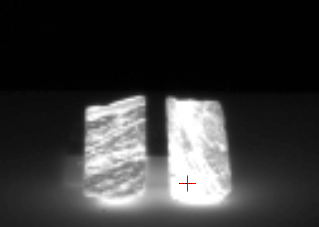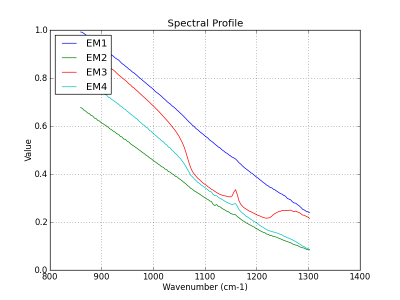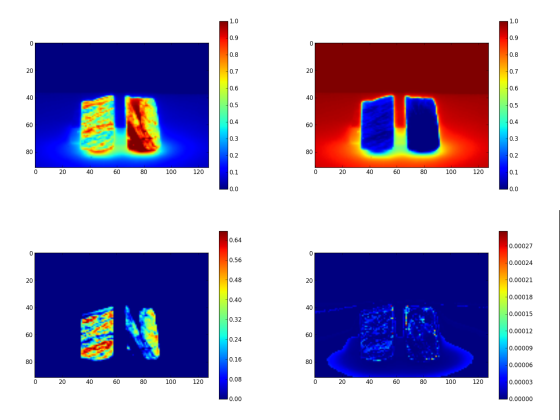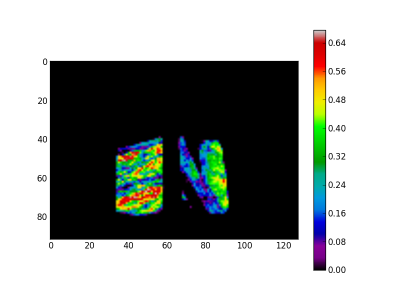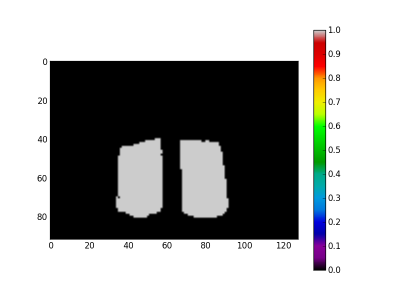Warm hematite drill core¶
A new version of the hematite example is introduced for the 0.12.0 version. The main improvement is to use FCLS instead of NNLS. With the introduction of FCLS a higher precision is obtained and only four endmembers is needed to map the quartz and, this is new, to define the mask. You can consult the version 0.11.0 for the previous analysis.
Quartz and feldspar have absorption feature in the LWIR range. Hematite (Fe2O3) has no absorption feature in the sensor spectral range. The dark regions correspond to a quartz (SiO2) impurity in the sample (figure 1). The broad spectral feature between 1050 and 1275 cm-1 is associated with the Si-O asymmetric stretching mode of quartz. The cube is acquired in the VLW range of infrared, between 867 to 1288 wavenumber (cm-1) (7.76 to 11.54 micrometer) and it have 165 bands. The instrument used to acquire the data come from the Telops compagny.
The analysis is made in tree steps. First, we extract four endmembers. Next, the related abundance maps are generated with FCLS. At the figure 2, you see the extracted endmembers and at the figure 3, the abundance maps.
For the last step we use the EM2 and EM3 spectra to create the mask and the quartz images respectively. Creation of the quartz image is straightforward. The EM2 spectra is a background spectra. Inverting it give a mask for the drill core. At the figure 4 the quartz image is presented and at the figure 5 the mask image.
And the last step consist to extract some statistics. The results are:
- Drill core surface (mask) in pixels: 1718
- Quartz surface in pixels: 1163
- Hematite surface in pixels: 555
Code follow:
"""
Plot a quartz class map for a drill core HSI cube.
"""
from __future__ import print_function
import os
import os.path as osp
import matplotlib.pyplot as plt
import numpy as np
import pysptools.util as util
import pysptools.eea as eea
import pysptools.abundance_maps as amp
def parse_ENVI_header(head):
ax = {}
ax['wavelength'] = head['wavelength']
ax['x'] = 'Wavelength - '+head['z plot titles'][0]
ax['y'] = head['z plot titles'][1]
return ax
def get_endmembers(data, info, q, path):
print('Endmembers extraction with NFINDR')
ee = eea.NFINDR()
U = ee.extract(data, q, maxit=5, normalize=True, ATGP_init=True)
ee.plot(path, axes=info)
return U
def gen_abundance_maps(data, U, result_path):
print('Abundance maps with FCLS')
fcls = amp.FCLS()
amap = fcls.map(data, U, normalize=True)
fcls.plot(result_path, colorMap='jet')
return amap
def plot(image, colormap, desc, path):
plt.ioff()
img = plt.imshow(image, interpolation='none')
img.set_cmap(colormap)
plt.colorbar()
fout = osp.join(path, 'plot_{0}.png'.format(desc))
plt.savefig(fout)
plt.clf()
if __name__ == '__main__':
# Load the cube
data_path = os.environ['PYSPTOOLS_DATA']
home = os.environ['HOME']
result_path = os.path.join(home, 'results')
sample = 'hematite.hdr'
data_file = osp.join(data_path, sample)
data, header = util.load_ENVI_file(data_file)
if osp.exists(result_path) == False:
os.makedirs(result_path)
axes = parse_ENVI_header(header)
# Telops cubes are flipped left-right
# Flipping them again restore the orientation
data = np.fliplr(data)
U = get_endmembers(data, axes, 4, result_path)
amaps = gen_abundance_maps(data, U, result_path)
# EM4 == quartz
quartz = amaps[:,:,3]
plot(quartz, 'spectral', 'quartz', result_path)
# EM1 == background, we use the backgroud to isolate the drill core
# and define the mask
mask = (amaps[:,:,0] < 0.2)
plot(mask, 'spectral', 'mask', result_path)
# Plot the quartz in color and the hematite in gray
plot(np.logical_and(mask == 1, quartz <= 0.001) + quartz, 'spectral', 'hematite+quartz', result_path)
# pixels stat
rock_surface = np.sum(mask)
quartz_surface = np.sum(quartz > 0.16)
print('Some statistics')
print(' Drill core surface (mask) in pixels:', rock_surface)
print(' Quartz surface in pixels:', quartz_surface)
print(' Hematite surface in pixels:', rock_surface - quartz_surface)
